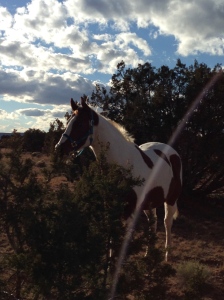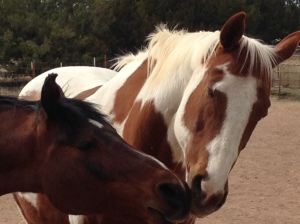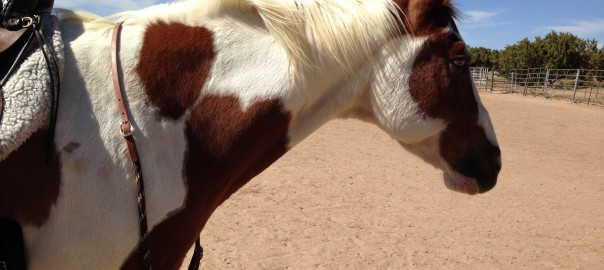From the standpoint of a bodyworker, when the horse has “had enough” is pretty obvious. But even so, students will continue to press on an area and worry over it even when the horse has moved away. Why don’t they see it? Feel it?
 It takes practice, because this is not what we are taught in our Western culture. We are taught that doing more and repetitively as in massage, and to drill, drill, drill, even when the body cries out that it has had enough.
It takes practice, because this is not what we are taught in our Western culture. We are taught that doing more and repetitively as in massage, and to drill, drill, drill, even when the body cries out that it has had enough. No pain no gain.
No pain no gain.
What I teach people to see and feel, before the horse has had enough, are the signs of that coming. Some horses are acquiescent and will simply give in to “doing more” but others will react, and sometimes that reaction can be dramatic.
A non-force approach for both bodywork and horse training is invaluable. Common practice is to “not let your horse get away with it” and “end on a good note” and “repetition makes the horse better.”
First of all, I’m not sure a lot of people know if their horse is “getting away with something.”
Recently someone came to me and said, I pushed my horse too far, he did what I said and did it beautifully, then I asked for another time, and he exploded.
When a horse explodes, forget about trying to initiate any more training or make it “right.” Or “end on a good note.” That’s history. And that’s exactly why force really doesn’t work, just as it doesn’t work to force your second-grader to recite times tables endlessly without a break. Sure you might get the job done, but he’s going to resent you for it, maybe blow up or end up in tears, and often blank out the lesson so you’ve taken five steps backward instead of forward. With the horse, the next time you go to get him, he might run to the far end of the pasture.
Sometimes you can’t end on a good note simply because the horse is thinking about the activity, confused and/or isn’t there yet. It doesn’t mean that he needs you to keep repeating it; it simply means the next time you come to that activity, he probably will have integrated it and knows how. There needs to be a pause built in there – a “space between the notes.”
In terms of “repetition makes the horse better,” yes, to an extent that is true, but constant drilling of the same thing has a dulling effect. We don’t like it either. I do notice that when I repeat something, it will become deeper in the horse, but the space between really makes that possible.
Let me give an example. My gelding Patches can be pushy. If I haven’t worked with him in awhile he can get a little full of himself, so it’s my job to sweetly remind him of his boundaries. One day this past week, I did some online work with Patches which he did very well. When we did some liberty work, he came so close I could feel the push in his shoulder – even though he didn’t physically touch me. I sent him off. He was with other horses, but it was clear he wanted to work with me and didn’t want to be sent away. He did not join the other horses. He came over tentatively to see if I would receive him, and when he was nice I gave him a pet.
I’d put out some cavalettis for a later lesson, but I wasn’t going to engage in that until I had this horse’s full attention. When he came over and stood beside me and blew out breath, I knew he was ready. He walked willingly toward the cavaletti and stepped over them beautifully – all at liberty. Then I could reward him.
This inspired my older gelding Khami to go over the cavaletti too, so he came over, nickered and began stepping forward to the cavaletti. He actually tried to bite the first one, but then went over them just fine at liberty.
 Now I could have asked those two boys to go over the cavaletti again, but I didn’t. Instead I didn’t do anything more with them. It was near dinner time. This was at the end of the lesson for Patches as we’d done quite a bit of liberty and online work first. So he’d been working for a couple of hours, with breaks in between.I like to end the lessons while the horse is still interested in the activity, not after he’s had enough of it.
Now I could have asked those two boys to go over the cavaletti again, but I didn’t. Instead I didn’t do anything more with them. It was near dinner time. This was at the end of the lesson for Patches as we’d done quite a bit of liberty and online work first. So he’d been working for a couple of hours, with breaks in between.I like to end the lessons while the horse is still interested in the activity, not after he’s had enough of it.
I like to work back and forth between online and liberty with my horses because I want them to make happy transitions between liberty, online and on-board work. I like to refine all those transitions with them so they can bring the joy of liberty to their other work.
I worked with Patches and the cavaletti again a couple of days later, without the other horses around. At first he was more interested in the possibility of treats on  the other side of the fence. The cavaletti were hooked into the fence so they didn’t roll. I could tell I needed to do some side-by-side walking with him to warm up before going over the cavaletti. Once he was engaged in that way, I introduced the idea of the cavaletti. At first, he wanted to walk around them, then I used the lead rope run through the clip as a liberty rein to guide him lightly toward the cavaletti.
the other side of the fence. The cavaletti were hooked into the fence so they didn’t roll. I could tell I needed to do some side-by-side walking with him to warm up before going over the cavaletti. Once he was engaged in that way, I introduced the idea of the cavaletti. At first, he wanted to walk around them, then I used the lead rope run through the clip as a liberty rein to guide him lightly toward the cavaletti.
Part of my work with him is to get him to travel light, and not pull on the lead. Working at liberty gets that lightness and willingness in place really well, and then the liberty rein acts as the bridge to the halter. Most horses have to be on the halter when moved from one enclosure to the next, so this is an important step. Of course, it’s possible to make horses light with just a halter and lead rope too. In training with the least amount of pressure over the cavaletti, I’ve also used a halter, but I prefer the liberty rein if the horse is ready for it because it seems to have more of a relationship to liberty.
I sensed that if I had tried this with the halter, especially after Patches had successfully gone over the cavaletti at liberty a few days earlier, he would have been bored. It has taken me a few tries to get Patches to respond lightly to the liberty rein, but he was ready today. I was able to just hold the liberty rein loosely as we went together over the cavaletti.
The liberty rein makes me more aware of my cues and my energy and position. I think people tend to rely on old habits of handling horses with halters on and I don’t want to fall into that. Ultimately using a liberty rein helps me in my halter work as well, makes me lighter and more conscious.
This story is really to illustrate a direction we can go with our liberty work. In this case, the direction was directed by what the horse needed to help him be a solid citizen — without threats and pressure.
Since then, both geldings have been eager to work with me again. In fact, I feel that Patches would love to do some kind of work all day long. He never wants to leave the work space. He has so much fun, he thinks his whole life should be like this. By keeping it simple, with him getting to make decisions it feels like something he wants to do, rather than me making him do it.
Watch this little video of my work with Patches. It is very different from the liberty rein work I did during the winter with my mare, Jazzmine. Jazzmine had a lot of online cavaletti work before she came to me and she goes over them lightly on the liberty rein; where as Patches was resistant at first and needs to find the lightness in himself. With each horse, I have found a way to do this work that they enjoy. And with each time, the horses have extended the length of time they can enjoy an activity, without getting to the “I’ve had enough” state.
[youtube http://www.youtube.com/watch?v=bYhYNmnVgu8&w=420&h=315] [youtube http://www.youtube.com/watch?v=6dEkR5PHAX0&w=560&h=315]****
(copyright: Susan Smith, OrthoHorse)
Services: Bodywork (Ortho-Bionomy for people, Equine Ortho-Bionomy): private sessions, tutorials, phone consultations, distance healing communication and gift certificates
Liberty Coaching: clinics, mini-clinics, workshops, private and semi-private sessions, tutorials, consultations: by appointment: 505.501.2478 or emailing susansmith@orthohorse.info Spring Lessons – semi-private, private and small group sessions. Scheduling now. Contact me for details.
If you want to host a clinic in your area, contact me to make arrangements. Prices will vary according to location and travel. susansmith@orthohorse.info 505-501-2478
I conducted a free Liberty Coaching Call on March 12. If you did not have a chance to listen, here is the link: http://www.susith.com/orthohorse/freehorseatlibcall.mp3
On the schedule for 2014:
June 14th – Trail Riding Clinic
Where: Headquarters Well, Caja Del Rio, Santa Fe
Time: 9 a.m.-noon
Limited to 4 riders.
Cost: $75
Do you have questions or difficulties riding on the trail with your horse? What would you like to know to make your ride more enjoyable?
Trail riding is not just about “controlling” your horse, it is about establishing a “centaur relationship” that can carry you through all kinds of challenges.
Come learn from a seasoned endurance rider the following tips:
- Trail etiquette
- How to be safe
- How to get your horse ready for a trail ride
- What to bring with you
- Training
When we ask a horse to listen to us when we’re on a trail with other horses, we’re asking her to engage with us instead of with the other horses and the distractions that can occur on the trail. In this way, trail riding exposes what is not working in the arena and it exposes where your relationship with your horse needs strengthening. Find out some similarities between liberty training and trail riding.
In this clinic we will talk first about preparation and then work on some ways to manage situations on the trail, while in the saddle. We will take a short trail ride.
Bring:
• Snacks
• Water for you and your horse
• Hay if you want it
• Helmet
• Tack (saddle & some sort of horse headgear required)
This clinic is full but there is a waiting list. Please get on it! Contact me for enrollment & liability forms and Payment information. PayPal & checks accepted.
Combining cumulative knowledge from over 18 years of endurance riding, Liberty Horsemanship and Ortho-Bionomy bodywork practice, Susan Smith brings a unique perspective to getting a horse and rider ready for the trail – in mind, body and spirit.
Liberty Foundation work is destined to deepen your trail experience.
Contact Susan Smith@ susansmith@orthohorse.info or 505-501-2478.
September 27-28 – Spirit Horse Ranch Two-Day Liberty Foundations Clinic, Oklahoma City, Oklahoma – Engaging the Hearts and Minds of Horses. Susan Smith and Ruella Yates, co-teaching. Contact me or Ruella at 405-771-4274 (ruella@libertyfoundations.com)




Outstanding blog, relating the ‘no force’ technique in both Liberty Training and your OrthoHorse work! Patches is doing great, too!
Ruella Yates
Liberty Foundations Trainer
Spirit Horse Ranch